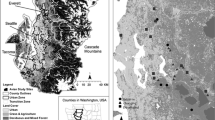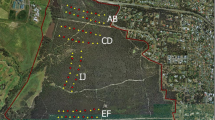Abstract
Context
Mechanisms of ecosystem change in urbanizing landscapes are poorly understood, especially in exurban areas featuring residential or commercial development set in a matrix of modified and natural vegetation. We asked how development altered trophic interactions and ecosystem processes in the matrix.
Objectives
We examined the effect of varying degrees of exurban development (housing density) on a trophic system that included an apex mammalian predator (coyote, Canis latrans), mammalian herbivores (lagomorphs and rodents), and herbaceous plants. We tested the hypothesis that plant recruitment would be negatively affected by exurban development due either to increases in herbivores associated with increased resource availability (a bottom–up effect) or to a reduction in predators that avoid humans (a top–down effect).
Methods
In Las Cruces, New Mexico, USA, four replicate sites were located in each of three urbanization levels: high density exurban, low density exurban, and wildland dominated by Chihuahuan Desert vegetation. Seedling trays measured herbivory rates, live trapping estimated abundance of pocket mice and kangaroo rats, and remotely-triggered wildlife cameras estimated the activity of lagomorphs and coyotes.
Results
Increased herbivory on seedlings and decreased herbaceous plant recruitment were observed in high density exurban areas. Overall rodent abundance, seed consumption rates, and activity of the lagomorph Lepus californicus did not vary with urbanization level. Activity by another lagomorph, Sylvilagus audubonii, and coyotes was highest in dense exurban areas, consistent with a bottom–up effect.
Conclusions
Exurban development can have important indirect effects on trophic interactions occurring in adjacent, untransformed ecosystems. Similar to earlier studies, such effects in the Chihuahuan Desert may be mediated by bottom–up processes associated with anthropogenic inputs.


Similar content being viewed by others
References
Anderson WB, Wait DA, Stapp P (2008) Resources from another place and time: responses to pulses in a spatially subsidized system. Ecology 89:660–670
Bengsen AJ, Leung LK-P, Lapidge SJ, Gordon IJ (2011) Using a general index approach to analyze camera-trap abundance indices. J Wildl Manag 75:1222–1227
Bestelmeyer BT, Khalil NI, Peters DPC (2007) Does shrub invasion indirectly limit grass establishment via seedling herbivory? A test at grassland-shrubland ecotones. J Veg Sci 18:363–370
Bestelmeyer BT, Okin GS, Duniway MC, Archer SR, Sayre NF, Williamson JC, Herrick JE (2015) Desertification, land use, and the transformation of global drylands. Front Ecol Environ 13:28–36
Bock CE, Jones ZF, Bock JH (2006) Abundance of cottontails (Sylvilagus) in an exurbanizing southwestern savanna. Southwest Nat 51:352–357
Brown JS, Kotler BP (2004) Hazardous duty pay and the foraging cost of predation. Ecol Lett 7:999–1014
Casini M, Blenckner T, Möllmann C, Gårdmark A, Lindegren M, Llope M, Kornilovs G, Plikshs M, Stenseth NC (2012) Predator transitory spillover induces trophic cascades in ecological sinks. Proc Natl Acad Sci USA 09:8185–8189
Cook WM, Faeth SH (2006) Irrigation and land use drive ground arthropod community patterns in an urban desert. Environ Entomol 35:1532–1540
Curtin CG, Kelt DA, Frey TC, Brown JH (2000) On the role of small mammals in mediating climatically driven vegetation change. Ecol Lett 2:309–317
Daniel A, Holecheck JL, Valdez R, Tembo A, Saiwana L, Rusco M, Cardenas M (1993) Range condition influences on Chihuahuan Desert cattle and jackrabbit diets. J Range Manag 46:296–301
ESRI (2014) ArcGIS Desktop: Release 10.2. Environmental Systems Research Institute, Redlands
Faeth SH, Saari S, Bang C (2012) Urban biodiversity: patterns, processes and implications for conservation. eLS. doi:10.1002/9780470015902.a0023572
Faeth SH, Warren PS, Shochat E, Marussich WA (2005) Trophic dynamics in urban communities. BioScience 55:399–407
Fedriani JM, Fuller TK, Sauvajot RM (2001) Does availability of anthropogenic food enhance densities of omnivorous mammals? An example with coyotes in southern California. Ecography 24:325–331
Fischer JD, Cleeton SH, Lyons TP, Miller JR (2012) Urbanization and the predation paradox: the role of trophic dynamics in structuring vertebrate communities. BioScience 62:809–818
Gehrt SD, Riley SPD (2010) Coyotes (Canis latrans). In: Gehrt SD, Riley SPD, Cypher BL (eds) Urban carnivores: ecology, conflict, and conservation. Johns Hopkins University Press, Baltimore, pp 79–98
Glennon MJ, Porter WF (2007) Impacts of land-use management on small mammals in the Adirondack Park, New York. Northeast Nat 14:323–342
Grimm NB, Grove JG, Pickett STA, Redman CL (2000) Integrated approaches to long-term studies of urban ecological systems. BioScience 50:571–584
Hansen AJ, Knight RL, Marzluff JM, Powell S, Brown K, Gude PH, Jones K (2005) Effects of exurban development on biodiversity: patterns, mechanisms, and research needs. Ecol Appl 15:1893–1905
Harris G, Thompson R, Childs JL, Sanderson JG (2010) Automatic storage and analysis of camera trap data. Bull Ecol Soc Am 91:352–360
Havstad KM, Gibbens RP, Knorr CA, Murray LW (1999) Long-term influences of shrub removal and lagomorph exclusion on Chihuahuan Desert vegetation dynamics. J Arid Environ 42:155–166
Henke SE, Bryant FC (1999) Effects of coyote removal on the faunal community in western Texas. J Wildl Manag 63:1066–1081
Herrick JE, Van Zee JW, Havstad KM, Burkett LM, Whitford WG (2009) Monitoring manual for grassland, shrubland, and savanna ecosystems. Volume 1: quick start. USDA-ARS Jornada Experimental Range, Las Cruces
Heske EJ, Brown JH, Guo Q (1993) Effects of kangaroo rat exclusion on vegetation structure and plant species diversity in the Chihuahuan Desert. Oecologia 95:520–524
Hines JE (2006) PRESENCE2- Software to estimate patch occupancy and related parameters. USGS-PWRC. http://www.mbr-wrc.gov/software/presence.html
Hunt VM, Magle SB, Vargas C, Brown AW, Lonsdorf EV, Sacerdote AB, Sorley EJ, Santymire RM (2013) Survival, abundance, and capture rate of eastern cottontail rabbits in an urban park. Urban Ecosyst 17:547–560
Hunter MD, Price PW (1992) Playing chutes and ladders: heterogeneity and the relative roles of bottom-up and top-down forces in natural communities. Ecology 73:724–732
Imhoff ML, Tucker CJ, Lawrence WT, Stutzer DC, Rusin RJ (2000) The use of multi-source satellite and geospatial data to study the effect of urbanization on primary productivity in the United States. IEEE Trans Geosci Remote Sens 38:2549–2556
Jennelle CS, Runge MC, MacKenzie DI (2002) The use of photographic rates to estimate densities of tigers and other cryptic mammals: a comment on misleading conclusions. Anim Conserv 5:119–120
Kerley GIH, Whitford WG, Kay FR (1997) Mechanisms for the keystone status of kangaroo rats: graminivory rather than granivory? Oecologia 111:422–428
Kitchen AM, Gese EM, Schauster ER (2000) Changes in coyote activity patterns due to reduced exposure to human persecution. Can J Zool 78:853–857
Laundré JW, Hernández L, Medina PL, Campanella A, López-Portillo J, González-Romero A, Grajales-Tam KM, Burke AM, Gronemeyer P, Browning DM (2014) The landscape of fear: the missing link to understand top-down and bottom-up controls of prey abundance? Ecology 95:1141–1152
Liere H, Kim TN, Werling BP, Meehan TD, Landis DA, Gratton C (2015) Trophic cascades in agricultural landscapes: indirect effects of landscape composition on crop yield. Ecol Appl 25:652–661
Loreau M, Mouquet N, Holt RD (2003) Meta-ecosystems: a theoretical framework for a spatial ecosystem ecology. Ecol Lett 6:673–679
MacKenzie DI, Nichols JD, Royle JA, Pollock KH, Bailey LL, Hines JE (2006) Occupancy estimation and modeling: inferring patterns and dynamics of species occurrence. Academic Press, Burlington
Magle SB, Hunt VM, Vernon M, Crooks KR (2012) Urban wildlife research: past, present, and future. Biol Conserv 155:23–32
Magle SB, Poessel SA, Crooks KR, Breck SW (2014a) More dogs less bite: the relationship between human-coyote conflict and prairie dog colonies in urban landscape. Landsc Urban Plan 127:146–153
Magle SB, Simoni LS, Lehrer EW, Brown JS (2014b) Urban predator-prey association: coyote and deer distributions in the Chicago metropolitan area. Urban Ecosyst 17:875–891
Manley PN, Murphy DD, Campbell LA, Heckmann KE, Merideth S, Parks SA, Sanford MP, Schlesinger MD (2006) Biotic diversity interfaces with urbanization in the Lake Tahoe Basin. Calif Agric 60:59–64
Meserve PL, Kelt DA, Milstead WB, Gutierrez JR (2003) Thirteen years of shifting top-down and bottom-up control. BioScience 53:633–646
Odell EA, Knight RL (2001) Songbird and medium-sized mammal communities associated with exurban development in Pitkin County, Colorado. Conserv Biol 15:1143–1150
Ordeñana MA, Crooks KR, Boydston EE, Fisher RN, Lyren LM, Siudyla S, Haas CD, Harris S, Hathaway SA, Turschak GM, Miles AK, Van Vuren DH (2010) Effects of urbanization on carnivore species distribution and richness. J Mammal 91:1322–1331
Pace ML, Cole JJ, Carpenter SR, Kitchell JF (1999) Trophic cascades revealed in diverse ecosystems. Trends Ecol Evol 14:483–488
Pejchar L, Reed SE, Bixler P, Ex L, Mockrin MH (2015) Consequences of residential development for biodiversity and human well-being. Front Ecol Environ 13:146–153
R Core Team (2014) R: a language and environment for statistical computing. R Foundation for Statistical Computing, Vienna. http://www.R-project.org
Randa LA, Yunger JA (2006) Carnivore occurrence along an urban-rural gradient: a landscape-level analysis. J Mammal 87:1154–1164
Robinson QH, Bustos D, Roemer GW (2014) The application of occupancy modeling to evaluate intraguild predation in a model carnivore system. Ecology 95:3112–3123
Rodewald AD, Kearns LJ, Shustack DP (2011) Anthropogenic resource subsidies decouple predator-prey relationships. Ecol Appl 21:936–943
Roth GA, Whitford WG, Steinberger Y (2007) Jackrabbit (Lepus californicus) herbivory changes dominance in desertified Chihuahuan Desert ecosystems. J Arid Environ 70:418–426
Šálek M, Drahníková L, Tkadlec E (2015) Changes in home range sizes and population densities of carnivore species along the natural to urban habitat gradient. Mamm Rev 45:1–14
Sanderson J, Harris G (2013) Automatic data organization, storage, and analysis of camera trap pictures. J Indones Nat Hist 1:6–14
Shochat E, Warren PS, Faeth SH, McIntyre NE, Hope D (2006) From patterns to emerging processes in mechanistic urban ecology. Trends Ecol Evol 21:186–191
Stapp P, Polis GA (2003) Marine resources subsidize insular rodent populations in the Gulf of California, Mexico. Oecologia 134:496–504
Theobald DM (2014) Development and applications of a comprehensive land use classification and map for the US. PLoS One 9:e94628
Theobald D, Travis W, Drummond M, Gordon E, Betsill M (2013) The changing southwest. In: Garfin G, Jardine A, Merideth R, Black M, LeRoy S (eds) Assessment of climate change in the southwest United States. Island Press/Center for Resource Economics, Washington, DC, pp 37–55
Turkowski FJ (1975) Dietary adaptability of the desert cottontail. J Wildl Manag 39:748–756
Waser N, Price M, Blumstein D, Arózqueta SR, Escobar BC, Pickens R, Pistoia A (2014) Coyotes, deer, and wildflowers: diverse evidence points to a trophic cascade. Naturwissenschaften 101:427–436
White GC, Burnham KP (1999) Program MARK: survival estimation from populations of marked animals. Bird Study 46:120–138
York AM, Shrestha M, Boone CG, Zhang S, Harrington JA Jr, Prebyl TJ, Swann A, Agar M, Antolin MF, Nolen B, Wright JB, Skaggs R (2011) Land fragmentation under rapid urbanization: a cross-site analysis of Southwestern cities. Urban Ecosyst 14:429–455
Acknowledgments
This study was funded by the National Science Foundation through the Jornada Basin LTER site (DEB0080412) and by T&E, Inc. We thank William Gould and Darren James for statistical help and Mark Andersen and Donovan Bailey for suggestions and comments on earlier versions of this work. We also thank Maria Chavez for help in the field. Finally, we thank the Bureau of Land Management for coordinating use of the wildland sites and several Las Cruces residents for allowing us the use of their yards.
Author information
Authors and Affiliations
Corresponding author
Electronic supplementary material
Below is the link to the electronic supplementary material.
Rights and permissions
About this article
Cite this article
DaVanon, K.A., Howard, L.K., Mabry, K.E. et al. Effects of exurban development on trophic interactions in a desert landscape. Landscape Ecol 31, 2343–2354 (2016). https://doi.org/10.1007/s10980-016-0403-9
Received:
Accepted:
Published:
Issue Date:
DOI: https://doi.org/10.1007/s10980-016-0403-9




